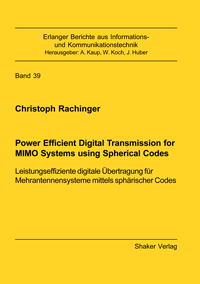
Shop : Details
Shop
Details
48,80 €ISBN 978-3-8440-5964-9Softcover196 pages94 figures273 g21 x 14,8 cmEnglishThesis
June 2018
Christoph Rachinger
Power Efficient Digital Transmission for MIMO Systems using Spherical Codes
Leistungseffiziente digitale Übertragung für Mehrantennensysteme mittels sphärischer Codes
In this work, we investigate whether so-called spherical codes, i.e., codes with code words that are distributed over the surface of a multidimensional hypersphere in a Euclidean space, are suited as modulation alphabets for digital transmission over multiple-antenna systems. Using spherical codes as a modulation alphabet is called Phase Shift Keying on the Hypersphere (PSKH), because it can be understood as a generalization of conventional Phase Shift Keying (PSK). If PSKH is used in combination with suitable amplifiers in the output stage of a transmitter, so-called load modulated amplifiers, the power efficiency of a digital transmission system can be improved.
This work begins by comparing different methods to generate spherical codes with respect to power efficiency in the case of coded and uncoded transmission. It turns out that large minimum distance does not necessarily result in high power efficiency in the coded case when combined with Bit-Interleaved Coded Modulation (BICM).
Furthermore, methods to reduce the Peak-to-Average-Sum-Power-Ratio (PASPR) are analyzed. Achieving a low PASPR is vital to fully exploit load modulated transmitters. The PASPR reduction can be achieved in two ways: Either by modifying the pulse shaping at the transmitter, or by using rotated versions of a base constellations. The latter method is termed pi/2-shifted PSKH. In this work, pi/2-shifted PSKH is thoroughly analyzed both in terms of capacity and power efficiency, whereby different receiver algorithms are introduced and compared with respect to performance and computational complexity.
This work begins by comparing different methods to generate spherical codes with respect to power efficiency in the case of coded and uncoded transmission. It turns out that large minimum distance does not necessarily result in high power efficiency in the coded case when combined with Bit-Interleaved Coded Modulation (BICM).
Furthermore, methods to reduce the Peak-to-Average-Sum-Power-Ratio (PASPR) are analyzed. Achieving a low PASPR is vital to fully exploit load modulated transmitters. The PASPR reduction can be achieved in two ways: Either by modifying the pulse shaping at the transmitter, or by using rotated versions of a base constellations. The latter method is termed pi/2-shifted PSKH. In this work, pi/2-shifted PSKH is thoroughly analyzed both in terms of capacity and power efficiency, whereby different receiver algorithms are introduced and compared with respect to performance and computational complexity.
Keywords: MIMO; Communications Engineering; Information Theory; Coding Theory
Erlanger Berichte aus Informations- und Kommunikationstechnik
Edited by Prof. Dr. J. Huber, Prof. A. Kaup and Prof. Dr. W. Koch, Erlangen-Nürnberg
Volume 39
Available online documents for this title
You need Adobe Reader, to view these files. Here you will find a little help and information for downloading the PDF files.
Please note that the online documents cannot be printed or edited.
Please also see further information at: Help and Information.
Please also see further information at: Help and Information.
| Document |  | Document | ||
| Type |  | |||
| Costs |  | 36,60 € | ||
| Action |  | Purchase in obligation and download the file | ||
| Document |  | Table of contents | ||
| Type |  | |||
| Costs |  | free | ||
| Action |  | Download the file | ||
User settings for registered online customers (online documents)
You can change your address details here and access documents you have already ordered.
User
Not logged in
Export of bibliographic data
Shaker Verlag GmbH
Am Langen Graben 15a
52353 Düren
Germany
Am Langen Graben 15a
52353 Düren
Germany
Mon. - Thurs. 8:00 a.m. to 4:00 p.m.
Fri. 8:00 a.m. to 3:00 p.m.
Fri. 8:00 a.m. to 3:00 p.m.
Contact us. We will be happy to help you.



